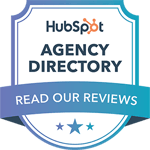
A well-designed B2B landing page grabs the attention of a potential customer, offers value, and pushes visitors down the conversion funnel. That’s why you should pay attention to how it’s designed and what message it shows to the targeted audience.
An optimized landing page can increase lead generation, shorten the sales cycle, and drive conversions. You can turn passive visitors into qualified leads by offering a clear value proposition.
An effective landing page addresses common pain points and showcases solutions, easing decision-makers through the funnel faster. Whether they sign up for a webinar, download a whitepaper, or request a demo, the page helps push prospects to take action.
How a B2B Landing Page Differs From a B2C Landing Page
A B2B landing page is typically designed to capture leads from businesses. It could promote a product, service, or resource like an ebook or webinar. It’s different from a B2C landing page because the target audience is not an individual consumer but a decision-maker or group of stakeholders within a company.
Purchase decisions are more complex, often involving multiple steps and people, which means your landing page needs to appeal to professionals looking for solutions to real business problems.
B2B vs. B2C Landing Pages
While both B2B and B2C landing pages are built for conversion, there are significant differences:
|
B2B landing pages |
B2C landing pages |
|
|
Audience |
Targets specific roles within organizations (e.g., CEOs, managers, procurement officers) |
Focuses on a broader consumer base |
|
Content |
Prioritizes detailed, data-driven content that addresses business challenges |
Emphasizes emotional and lifestyle appeal |
|
Objectives |
Aims to foster long-term relationships and nurture leads |
Focuses on immediate purchases |
While B2C landing pages often focus on immediate conversions, B2B messages are more data-driven and solution-oriented. The goal isn’t always to get an immediate "buy now" but to build a relationship that could lead to a contract.
| For example, while a B2C landing page for a clothing brand might rely on visually appealing images and discounts to prompt a quick purchase, a B2B page for a SaaS company would focus more on ROI, product features, and long-term value. The messaging needs to be clear, relevant, and tailored to the specific pain points of businesses, not individuals. |
The Anatomy of a High-Converting Landing Page
What makes some landing pages perform better than others? While there’s no one-size-fits-all formula, there are certain elements that successful B2B landing page design should follow.
First and foremost is clarity. Your landing page needs to be simple and easy to read, using clean layouts, minimal distractions, and mobile responsiveness to ensure a seamless user experience for busy decision-makers.
Also, your headline should grab attention immediately, telling visitors exactly what your offer is and why they should care. The messaging should be specific and directly address the problems your potential clients are facing. Avoid being vague—get to the point quickly.
Next comes the offer itself. Whether it’s a free trial, an ebook, or a consultation, your offer needs to provide immediate value to your target audience. It’s not enough to explain what your product does; you need to show how it solves a business problem.
|
Maximize your landing page potential Partner with our SEO specialists to create high-converting landing pages tailored to your business needs. Learn how our expertise can elevate your marketing effort and drive more leads. |
Social proof is another essential element. Businesses want to know they’re working with a trustworthy and experienced company, so include testimonials, case studies, or statistics that demonstrate your credibility.
Of course, there’s the call to action (CTA). A good CTA is clear, action-oriented, and prominent. Whether it’s "Download the Guide" or "Request a Free Demo," make sure the CTA is easy to find and stands out visually on the page.
Lastly, don’t forget about design and user experience. Keep things simple and distraction-free. The layout should be clean, easy to navigate, and optimized for mobile devices.
6 High-Converting B2B Landing Page Examples
Now, let’s get into the meat of it. These examples showcase B2B landing pages that get it right regarding design, content, and conversion potential.
1. NP Digital
Neil Patel's consulting landing page is based on credibility and trust-building. Right from the start, the page emphasizes Neil Patel's authority in the marketing world, showcasing social proof like client testimonials, media features, and case studies. These elements work to immediately establish trust with potential clients. The clean, focused design has a single, simple CTA ("Book a call") that drives the visitor toward conversion. This page effectively funnels visitors into contacting the consulting team by removing distractions and highlighting key benefits.
Why does it convert?
Neil Patel leverages his personal brand and social proof to build trust instantly. The focused CTA guides the visitor to take action quickly.
2. Asana
Asana’s landing page for organizational planning focuses on business-specific pain points, such as streamlining workflows and improving team productivity. The page offers clear and structured information, using concise copy and visuals to demonstrate Asana’s features in action.
By presenting product screenshots and customer use cases, the page helps B2B users quickly understand how Asana can solve their organizational challenges. At the same time, multiple CTAs make it easy to sign up or explore further.
3. Divante
This landing page provides a clear and well-structured value proposition for businesses seeking Pimcore development services. Right at the top, they make it obvious what they offer, followed by a breakdown of their services, the industries they serve, and the outcomes they deliver.
The visual hierarchy is strong—each section flows naturally, guiding the user down the page with relevant information at each step. Multiple CTAs throughout the page invite visitors to contact them for tailored solutions. This balance between detailed information and well-placed CTAs makes it easy for users to navigate and take action.
This landing page simplifies complex services by clearly explaining their offerings and using CTAs strategically throughout the page to maintain momentum and guide users toward conversion.
4. Zoho CRM
Zoho's CRM landing page is an example of how to blend storytelling with conversion-focused design. It doesn't just describe features; it tells a story about building "everlasting customer relationships," which resonates emotionally with B2B buyers looking for long-term solutions.
The design is minimalistic, focusing on Zoho's CRM's benefits. The page also features multiple CTAs ("Ge started") in prominent positions, encouraging visitors to take immediate action. Using client testimonials and success stories further builds trust, while the clear and concise messaging makes the benefits easy to digest.
The page taps into an emotional connection by focusing on long-term customer relationships, while the CTAs and social proof reinforce credibility and encourage users to start a free trial.
5. Slack
Slack’s landing page does a fantastic job of simplifying the complex task of team communication for B2B users. It highlights the core benefits of Slack’s instant messaging system, providing clear, actionable information on how it improves team collaboration.
The page uses engaging visuals, clean copy, and real-world examples of Slack in use. The "Get Started" CTA is strategically placed, making it easy for potential customers to take the next step. The page is also highly optimized for SEO and mobile, ensuring a smooth experience across devices for decision-makers on the go.
6. TeamSupport
The TeamSupport landing page focuses on product benefits and solving customer pain points. It highlights exactly how their ticket management system can ease customer support processes and improve efficiency, directly addressing potential buyers' concerns.
The page uses strong visuals and concise copy to keep the user engaged without overwhelming them with too much information. The CTAs like "Book a Demo" are well-placed and action-oriented, ensuring that the visitor is always directed toward the next logical step. Additionally, the page includes case studies and client logos, which act as social proof to reassure potential customers of its effectiveness.
It speaks directly to customer pain points, offers clear solutions, and backs them up with client success stories while maintaining a user-friendly design and flow.
These are just a few examples, but you’ll notice a pattern: clarity, strong CTAs, social proof, and simplicity are key elements that make these pages successful.
|
Maximize your landing page potential Partner with our SEO specialists to create high-converting landing pages tailored to your business needs. Learn how our expertise can elevate your marketing effort and drive more leads. |
B2B Landing Page Template for Easy Customization
Now that you’ve seen some top examples let’s talk templates. Not everyone has the time or resources to design a landing page from scratch, which is where customizable templates come in. These templates can save you time and effort while allowing you to create a page tailored to your brand and audience.
For example, if you’re in the SaaS space, you might opt for a template that highlights product features and focuses on lead generation. Finance companies, on the other hand, might prefer a more trust-focused template that emphasizes security and compliance. Manufacturing businesses could use a visual-heavy template that showcases efficiency and client success stories.
The beauty of templates is that they’re flexible. You can customize them to reflect your brand’s style, tone, and messaging while sticking to the best design and conversion optimization practices.
Template Example:
Here’s a customizable B2B landing page template designed to be flexible. This template has all the key elements:
- A clear headline
- A value proposition
- Testimonials
- A focus on benefits and features
- Multiple calls-to-action (CTAs)
It’s easy to adapt by switching out the text with your unique offering and industry.
|
[Headline]: Subheadline (Optional): Introductory Text: CTA Button: [Section 1]: How We Help You [Solve Problem] We understand that [target audience’s industry pain point]. That’s why we created [Your Product/Service] to deliver a seamless experience for [specific solution]. Key Benefits (Short, compelling sentence explaining each benefit):
[Section 2]: Why Choose [Your Product/Service]? Our platform is trusted by [credible companies], and here’s why it works for them (and will for you):
Visual Suggestion: [Section 3]: Real Results from Real Businesses Don't just take our word for it – see how [Your Product/Service] has impacted businesses like yours. Client Testimonial 1: Client Testimonial 2: Visual Suggestion: [Section 4]: Features that Set Us Apart We provide all the tools you need to succeed. Here are some of our standout features:
CTA Button: [Section 5]: Let’s Get Started! Ready to [solve pain point] and [achieve the desired outcome]? Don’t wait—let’s build something unique together. CTA Button: [Footer Section]:
|
How to Customize Landing Page Templates
When customizing B2B landing page templates, align the design and messaging with your brand identity and target audience.
Start by incorporating your brand’s colors, fonts, and logo for visual consistency. But don't stop there—tailor the content to address the specific pain points of your target decision-makers. If you're selling software to CTOs, your copy should emphasize technical solutions, while a pitch to marketing executives might focus on boosting ROI.
Personalization is about making your prospects feel like the page speaks directly to their needs and challenges. Remember, even small details like personalized greetings or dynamic content blocks that adjust based on the visitor’s industry can make a huge difference in engagement and conversion.
A/B Testing
Implement A/B testing regularly to improve B2B landing page conversion rates. This will help you refine your messaging and optimize the page’s loading speed to minimize bounce rates and maximize lead generation.
Image source: Medium
Start by testing high-impact elements, such as headlines, CTAs, and visuals, and then move to smaller details like button colors or form length. Remember to test one change at a time to pinpoint what’s working. Consistent A/B testing allows you to learn what resonates most with your audience and continuously improve your page’s performance.
Conversion Rate Optimization (CRO) Strategies: Techniques to Improve Performance
Once you’ve personalized your landing page and tested variations, it’s time to focus on conversion rate optimization (CRO). CRO strategies include streamlining forms to reduce friction (fewer fields are usually better), creating a sense of urgency with limited-time offers, and enhancing your CTA buttons with action-oriented language.
Image source: Dynamic Yield
One of the B2B landing page best practices is using social proof, such as testimonials or case studies, to build trust. Heatmap tools can help you track where visitors are dropping off, providing insights into which sections might need tweaking to increase conversions.
Common Pitfalls to Avoid When Creating B2B Landing Pages
Overcomplicating the Design
One of the most common mistakes is overloading your landing page with too much information or elements. While showcasing every feature of your product or service might be tempting, keeping things simple and focused is essential.
A cluttered page can overwhelm visitors and dilute your message. Instead, highlight the core benefits and make your CTA easy to find. Minimalism, especially in B2B, allows your message to stand out and makes it easier for visitors to take action.
The Importance of Responsive Design
Failing to optimize your landing page for mobile devices can cost you leads. Many B2B decision-makers browse on their phones, especially while on the go. Make sure your page is responsive and adapts seamlessly to different screen sizes.
Mobile optimization includes everything from ensuring quick load times to making buttons large enough to be tapped easily and forms easy to fill out on smaller screens. A responsive design can significantly impact user experience and conversion rates.
Forgetting to Follow Up
The conversion process doesn’t end when someone submits a form. Following up with a well-designed thank you page and automated email sequence is essential for nurturing leads.
A good thank you page can confirm that the visitor’s action was successful, provide the next steps (like downloading a resource or scheduling a demo), and suggest additional content. Automated emails keep the conversation going, helping to build a relationship and guide the lead further down the funnel. Don’t miss this opportunity to maintain engagement.
From Templates to Success
High-converting B2B landing pages are great for driving leads and business growth. By understanding key elements like design simplicity, mobile responsiveness, and the importance of follow-up, you can create landing pages that truly resonate with your audience.
The examples and templates provided in this article give you a solid starting point—personalize, test, and optimize them based on your unique business needs.
|
Maximize your landing page potential Partner with our SEO specialists to create high-converting landing pages tailored to your business needs. Learn how our expertise can elevate your marketing effort and drive more leads. |





